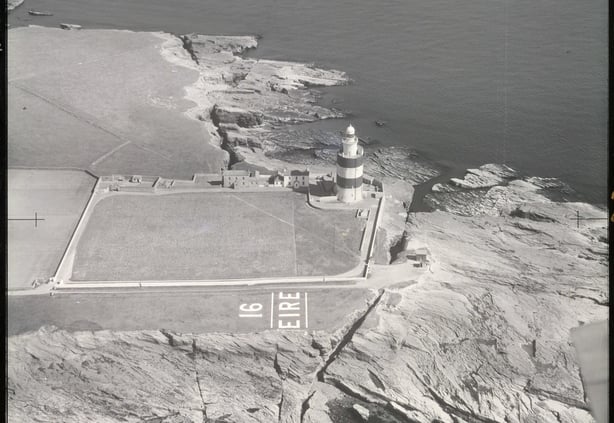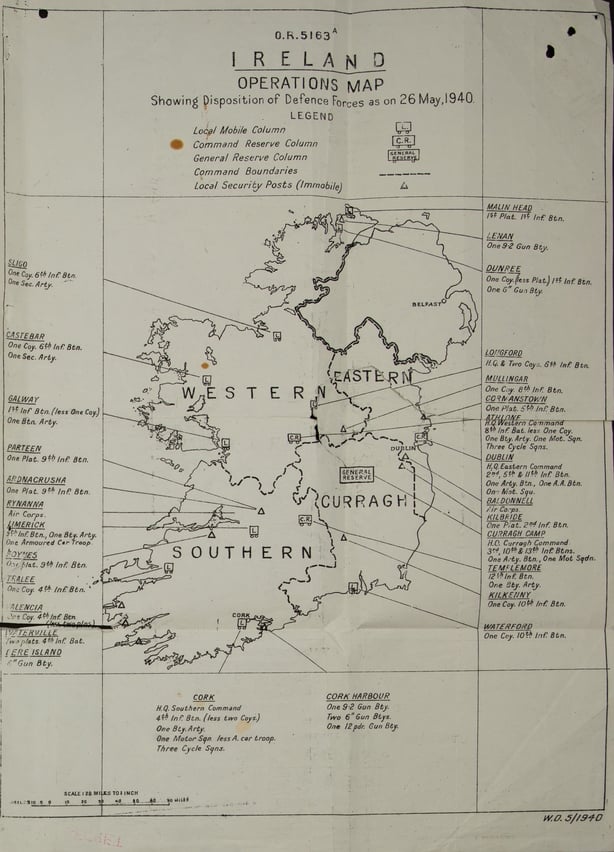Analysis: the establishment of the 18th Military Mission in June 1940 provided a vital conduit between Ireland and Britain during the war
By Eoin Kinsella, Royal Irish Academy
On the day the Second World War broke out, Michael Rynne, legal adviser at the Department of External Affairs, observed that Ireland's neutrality had to maintain 'complete impartiality in our relations with the two belligerents, abstaining from any action which might amount to auxiliary aid to one of the combatants.' to comply with international law. While Rynne’s analysis was perfectly correct, Ireland's geopolitical importance meant it was one to which the Government was neither inclined nor capable of adhering to as the war progressed.
That Ireland's neutrality was heavily inclined in favour of the Allies has become more widely recognised in recent years. Restorations of several of the numbered Éire signs (83 in all) that dotted the Irish coast during the Emergency has drawn attention to the fact that the American and British governments were given the co-ordinates of each sign, but the Germans were not.
Allied airmen and seamen that crash-landed in Ireland or washed up on our shores were quietly escorted over the border into Northern Ireland. Their German counterparts were detained in comfortable surroundings at the K-Lines camp in the Curragh. The Defence Forces' Intelligence branch G2 shared its success in decrypting German ciphers with British intelligence, while meteorological data was shared with the British throughout the war. Most famously, reports from Blacksod lighthouse enabled Allied planners to make last-minute adjustments and postpone the D-Day landings in June 1944.
We need your consent to load this rte-player contentWe use rte-player to manage extra content that can set cookies on your device and collect data about your activity. Please review their details and accept them to load the content.Manage Preferences
From RTÉ's Storm Front in Mayo documentary, how Mayowoman Maureen Sweeney played a critical role in D-Day landings in World War II with weather readings from the Blacksod weather station
But the levels of co-operation went much deeper still. Though diplomatic tensions with Britain remained on a knife edge for most of 1940 and 1941, the surrender of France in June 1940 both heightened the danger of a pre-emptive British invasion of Ireland, and accelerated contacts between the general staffs of the British and Irish forces.
The establishment of the 18th Military Mission (18MM) in June 1940 provided a vital conduit between both staffs. It was one of several missions created by Britain to liaise with friendly forces during the war, and 18MM was tasked with fostering 'proper co-operation' with the Defence Forces. Ensuing contacts contributed to a significant easing of the likelihood of a British invasion of Ireland, instead facilitating preparations for British forces to support Irish troops in the event of a German invasion.
Information was exchanged in a variety of ways, albeit sometimes warily. The British sent highly detailed questionnaires to the Defence Forces’ general staff, seeking detail on virtually every aspect of Irish defence planning and operational matters, including communication networks in Dublin and plans for large-scale civilian evacuations.

Eight lengthy questionnaires were submitted between May 1940 and January 1942, along with dozens of ad hoc requests for other details as the war progressed. Col. Seán Collins-Powell (nephew of Michael Collins and a future chief of staff of the Defence Forces) served as unofficial chief liaison officer with 18MM, frequently travelling to Northern Ireland for meetings and to observe training exercises.
The Defence Forces’ engagement with these questionnaires varied. Occasionally, the information requested was unavailable and required specialised research, as in the case of a request for suitable coastal locations for the landing of armoured fighting vehicles and other arms. In at least one instance, when the British inquired as to the numerical strength of each battalion in August 1940, the information supplied was deliberately altered to conceal weaknesses.
Chief of Staff Dan McKenna was given considerable latitude in his dealings with Allied forces. In May 1941 the Minister for Defence, Oscar Traynor, advised him to proceed slowly; when McKenna pointed out that swift co-operation might prompt the British to send some badly needed military equipment, Traynor proved willing to defer to his chief of staff's discretion.

Information also flowed in the other direction. From as early as July 1940, 18MM shared nearly all training instructions issued to British troops in Northern Ireland and these were studied carefully by the Defence Forces' general staff. 18MM prepared special intelligence reports for the Defence Forces and, from November 1941, simply forwarded the original British War Office briefings. These in turn were summarised by G2 Branch for distribution to Irish commands.
After America entered the war diplomatic tensions dropped and the level of co-operation accelerated. Reciprocal visits by commanding officers between Dublin, Belfast and London increased in frequency, while the British were also permitted to establish coal and fuel dumps in Ireland. By October 224,000 gallons of petrol were in store at Carton House, Co. Kildare.
The locations of key transport infrastructure that the Defence Forces planned to destroy in the event of a German invasion were shared with 18MM, to ease their arrival in Ireland to help the fight against the Germans. As McKenna hoped, British willingness to supply material and equipment improved as the war progressed, if only marginally and in cases where it was of benefit to their own interests.
We need your consent to load this rte-player contentWe use rte-player to manage extra content that can set cookies on your device and collect data about your activity. Please review their details and accept them to load the content.Manage Preferences
From RTÉ Radio 1's History Show, Marc McMenamin reports on the role of the four mile 'Donegal Corridor' in the Battle of the Atlantic during World War II
Perhaps the most important logistical assistance provided to the British was the establishment of the Donegal air corridor, and the facilitation of troop movements on British and American 'civilian' flights through Foynes Airport, Limerick. Belligerent nations were technically not allowed to transport members of their armed forces through the airport if they were on active duty; that restriction was increasingly flouted as the war progressed.
18MM was effectively dismantled by August 1943, when most US and British troops in Northern Ireland were relocated to England, though Irish co-operation with the Allied forces continued until the end of the war under various programmes. The role of Ireland's foreign service in assiduously managing intermittently fraught relations with the British and American administrations has become well known. But the importance of the lines of communication established via 18MM, and the deft management by the Defence Forces’ general staff of the relationship with its British counterparts, deserve greater recognition.
The Irish Defence Forces, 1922–2022 is published by Four Courts Press
Dr Eoin Kinsella is managing editor of the Royal Irish Academy's Dictionary of Irish Biography
The views expressed here are those of the author and do not represent or reflect the views of RTÉ

